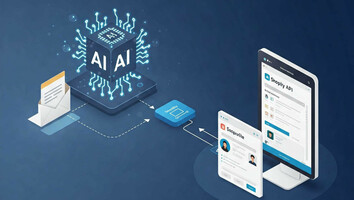NFTs are not just a trend. NFTs have swiftly become recognized as valuable, transferrable, and immutable assets on the blockchain. With time, NFT's recognition and capabilities have increased. This exemplifies how a huge populace finds NFT trading appealing. An NFT market is a location where trading takes place.
What is NFT?
NFT stands for a non-fungible token, a type of digital asset. It is described as non-transferable, one-of-a-kind data that is stored on a blockchain. NFTs are becoming more and more well-liked as more young people show interest in them. The NFT is a technology that can be incorporated into any blockchain, depending on the designer's engagement in the technology. In exchange for the cryptocurrencies, the developer lists the newly created NFTs on the NFT marketplaces via auction or open bidding.
8 Features of an NFT Marketplace
Listed below are the 8 important features of an NFT marketplace.
-
Storefront
An e-commerce website and an NFT marketplace are similar. It needs an inviting, appealing storefront. The administrator must select the number of details to show for each file.
However, for many NFTs of the same image artists choose to publish, only one NFT may be replicated.
-
Search Items
You must choose the types of files you will exchange while creating your own NFT marketplace. Open markets include early online marketplaces like OpenSea, which accept any NFT. Newer markets frequently concentrate on a specific specialty. Regardless of what you sell, your website needs to feature a search option to speed up the purchasing process.
-
Filters
Using search criteria might further enhance the purchasing experience. For collectors and investors who consider NFTs to be investments, there are different requirements. The ability to categorize products based on user choices, such as price, rarity, and artist, should be available.
-
Listings
Both buyers and sellers must enjoy using the NFT marketplace. When listing a file, well-designed NFT development provides a straightforward path to take. There should be forms on the marketplace that request selling information and instructions for uploading files.
-
Listing status
In an NFT transaction, both parties involved must be informed of the procedure. The marketplace can inform vendors about the number of viewers and bidders in an auction. When an offer is made, the website can notify users. Before making a purchase, customers want to be sure that a file has undergone verification. Collectors are particularly drawn to verified items.
-
Buying and Auction
Your website can include several selling mechanisms thanks to NFT engineers. Timed auctions are frequently the greatest way for well-known artists to sell their works because the price can rise quickly due to competition.
Payment channels for traditional e-commerce sites might not need as much coding, but using smart contracts on the blockchain does.
-
Wallet
The security of bitcoin wallets is a worry for tech-savvy customers on par with the security of any other financial data. Users should be able to utilize their current bitcoin wallet solutions on a new NFT marketplace.
-
Ratings
Ratings are a wonderful tool for customers and sellers alike. Strong reputations increase the likelihood of trading. Additionally, an evaluation mechanism can stop fraudulent activities like lying or redoing a transfer before the smart contract comes into effect.
Steps to Develop NFT Marketplace
Step 1: Conduct thorough market research
The first stage in developing an NFT marketplace is to conduct in-depth research on your target market, key rivals, and current crypto industry trends. You might find it easier to start working on your NFT marketplace development project if you choose certain expertise. If you have a general notion, discuss it with developers to determine a plan and determine when the market will start.
Step 2: Create a UI/UX design for your project
As soon as we have a clear understanding of the product strategy, we can move on to prototyping the user interface (UI). By now, you ought to be aware of your users' preferences for desktop experiences versus mobile apps.
In the prototyping stage, user journeys are described, mock screens are made for your NFT marketplace, and finally, the full user experience is fleshed out and tested (UX). After testing, you might want to make changes to the design to incorporate user feedback.
By using this method, you can avoid wasting time and resources on generating content that won't appeal to readers. The agile development method includes prototyping, which helps you quickly adapt and create a product that customers want and can understand.
Step 3: Smart Contracts
The usage of smart contracts is one of the most crucial components of creating an NFT marketplace. Smart contracts can be created on a variety of blockchain networks. The platform's smart contracts are created to the requirements of the corporate entity.
Smart contracts manage every part of your marketplace's operations, from listing to transaction. Smart contracts control every aspect of a decentralized network. As a result, developing a smart contract will be the main priority.
Two common types of NFT smart contracts are ERC-721, which produces a single asset, and ERC-1155, which enables you to have several products. These are built on the blockchain of Ethereum.
Step 4: Storage and Integration
The NFTs that will be placed on the market after minting must be saved, therefore they will be kept in IPFS while another user and NFT data is kept in a database. For this reason, users contribute digital items to promote their work. After building the user interface and setting up the NFT storage, the developed marketplace will be uploaded to the server and the front end and back end will be integrated. The primary responsibility of this stage is to provide the NFT market with reliable and quick processing capability.
Step 5: Testing and Deployment
The process of creating an NFT marketplace ends with this step. It's crucial to execute numerous tests after constructing and designing the market to check for errors or functional issues. To ensure that the market operates properly, several testing procedures will be used. The marketplace will open to all users globally once all the testing is over. This phase guarantees the reliability and superior usability of the software.
Business Use-Cases of The NFT Marketplace Development
The NFT markets have made significant progress to contribute significantly to the expanding economy and new commercial prospects. Several of the several approaches to NFT integration include:
-
Decentralized Finance
Long lines, overwhelming paperwork, and unethical activity are all coming to an end thanks to the financial sector's adoption of blockchain technology, which provides significant crypto quantities to carry out every banking transaction. Users can use their NFTs as collateral to secure a loan.
-
NFT Arts
With its ability to eliminate ownership and identity theft, NFT has transformed the artisan world by preserving the authenticity, integrity, and ownership of the rightful individual concerning the arts. For streamlining a second passive revenue stream, NFT arts remain at the top of the food chain.
-
NFT Gaming
A new era for the NFT gaming community has begun with the conversion of gaming assets, physical goods, and in-game assets including avatar personas, skins, apparel, objects, battle equipment, armor, environments, and everything in between into NFTs and selling them online.
-
NFT Fashion
Additionally, a large number of nimble and creative NFT-first fashion companies are producing digital clothing, frequently alongside real clothing, to sell to crypto-savvy consumers. This virtual couture may be worn using virtual and augmented reality technology. Haute couture is the ultimate collectible; thus, it makes sense that it would also be expanded into the NFT as a digital collectible.
-
Real–Estate NFT
NFT Marketplaces are raising the bar in all spheres of society, particularly in real estate. On the real estate NFT marketplaces, the real estate assets are converted into NFTs and listed. These plots and lands are leased and sold individually because they are a part of the blockchain network.
Final Thoughts
A team of professionals with years of experience and a reputable development partner, like Infinite Block Tech, who can help you create your own distinctive NFT Marketplace blockchain platform are required to establish a complicated platform like the NFT marketplace.



